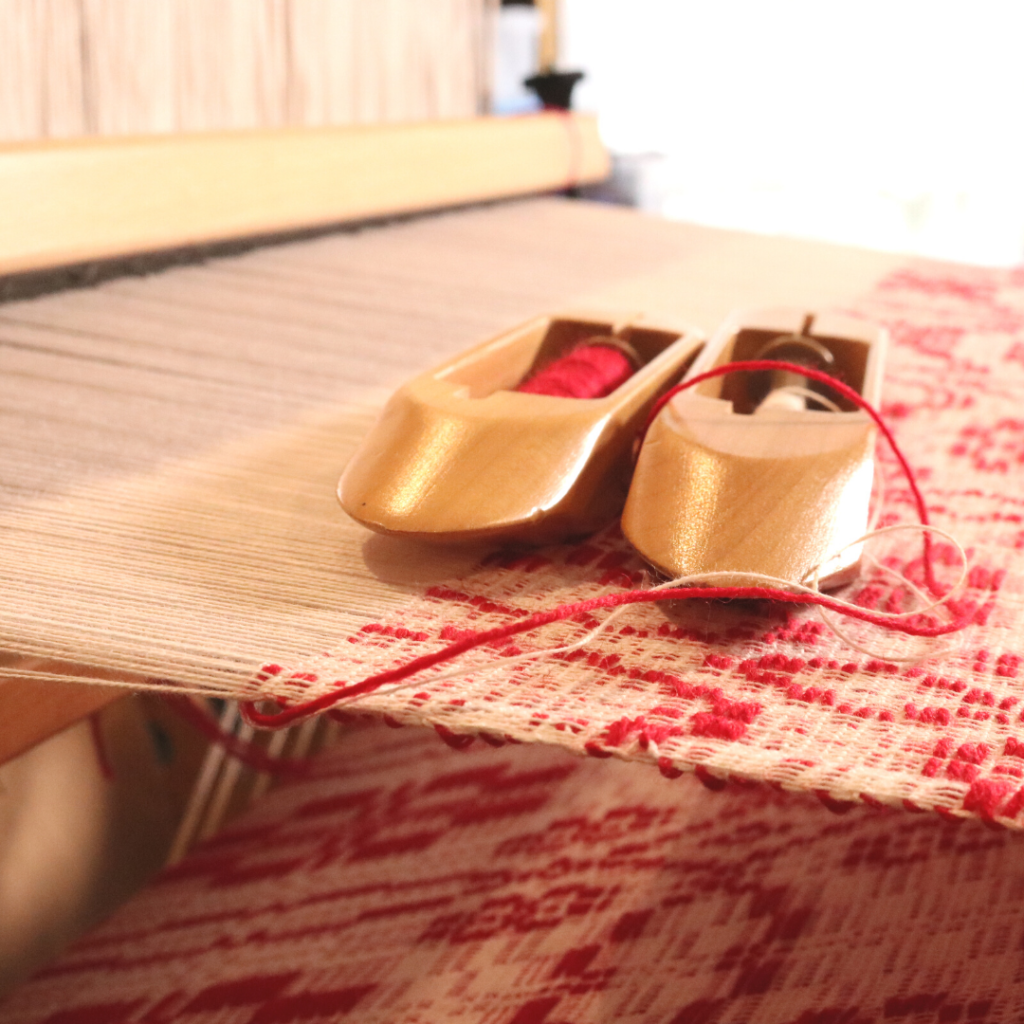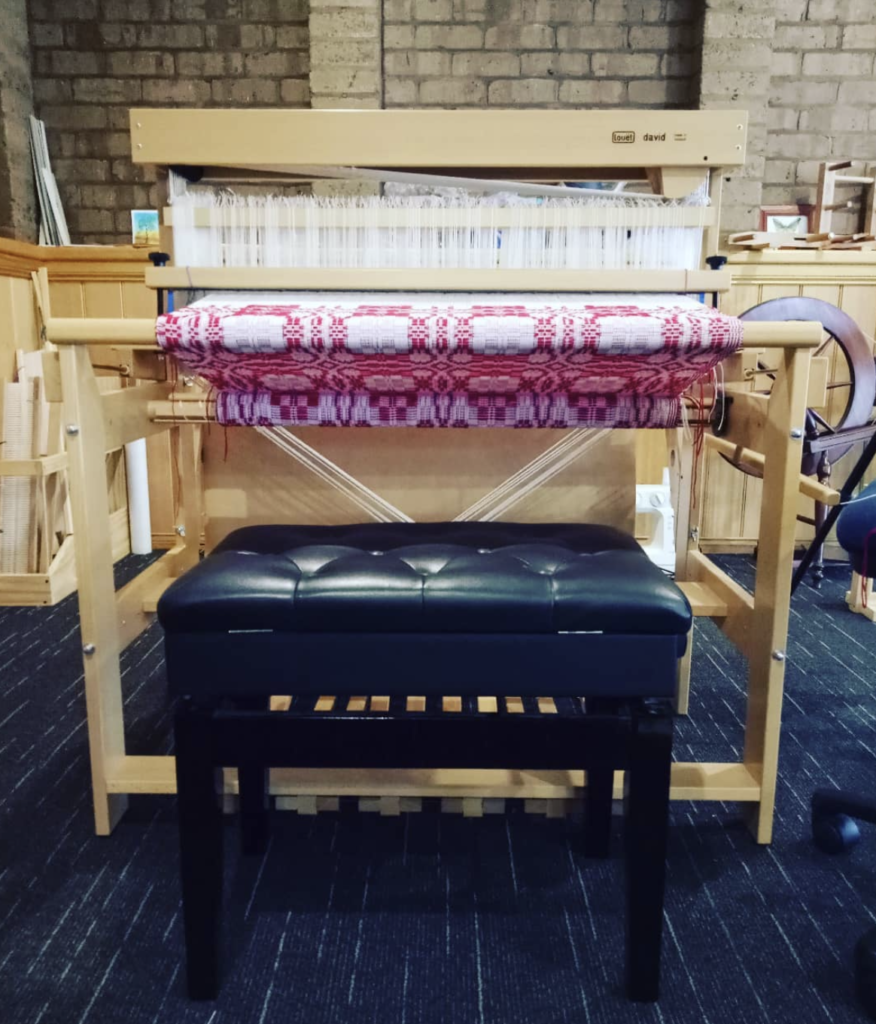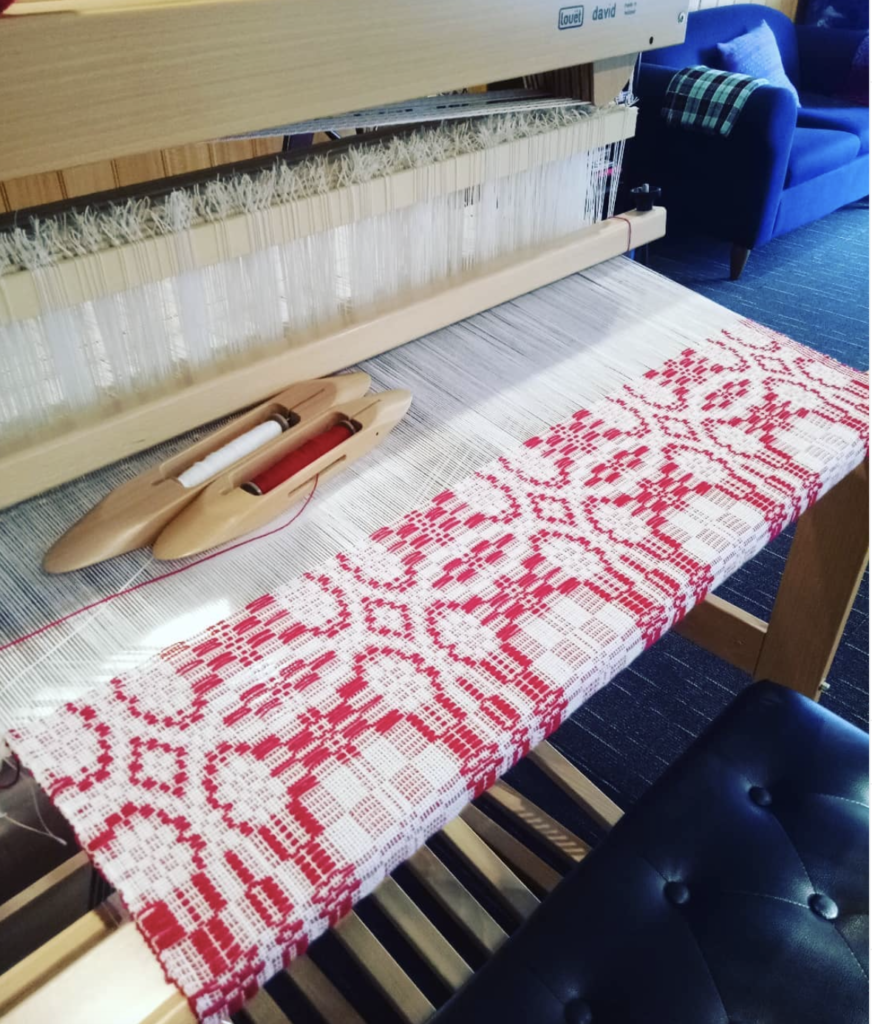I started my latest project full of enthusiasm and confidence.
I often feel at the beginning that whatever I’m working on is going to be my best piece yet. This is an important motivating tool for me and I’m sure that many of the projects I’ve undertaken would not have come to life without this initial confidence.
You could say that I felt super confident going into this new project. Experience with the weave structure? Check! Experience with the yarns? Check! Experience with the loom? Check, check, check!!
- This post contains affiliate links. For further information, please see my disclosure policy.
I thought I was cool with the long and wide warp. First mistake!
I should have asked someone to hold the warp for me so I could focus on winding it on. But no, being the “independent to my own detriment” kind of person that I am, I forged ahead alone.
Let me share some more details about this project. Those of you who have been around here for a while will be familiar with my bordering on obsessive desire to weave a full sized overshot coverlet, heavily influenced by the early American Woven Coverlets.
My main stumbling point to weaving my own coverlet is the seaming. Traditional coverlets were woven in panels, usually 2 or 3, then joined. Most looms were not wide enough for the full piece, and my 90cm width Louet David is no different.
The threading for the panels has to be arranged to be able to match up when the seams are joined. This usually consists of a centre panel and 2 panels either side (if weaving 3 panels). Then the seaming method has to be chosen with the view of minimising visibility – a really good coverlet weaver will have almost invisible seams.
Another essential aspect of successfully seaming the panels is to ensure a very consistent beat so that the pattern woven is continuous once the panels are joined. That means measuring picks per inch, something I’m not particularly fond of doing.
So, my idea was to weave just one panel and to practice rearranging threading and weaving a pleasing pattern. I even had the thought initially that I could use the panel to cut into pieces and make a patchwork quilt. I’m not sure the pattern lends itself well to a quilt, but I’m not too fussed about that. I will decide what to do with the piece once it’s off the loom.
For my warp I chose 8/2 cotton in white. I have a lot of experience with this yarn and have used it extensively in other overshot projects. Normally I pair it with a fingering weight wool for the pattern weft, but this time I decided to try Australian 3ply, which is in between a lace weight and fingering weight. In retrospect, I would have been better to sett a little closer than the 20 ends per inch I chose. There is more space between pattern wefts than I would like.
I found the weaving draft in Carol Strickler’s book “American Woven Coverlets”. I made some adjustments to the draft with plenty of calculations. Yet, when it came to the threading, I found that my warp was 16 threads short! I measured out the extra threads and weighted them over the back of the loom.
After threading and sleying the 650 ends I was looking forward to weaving! But my less than ideally tensioned warp came back to bite me at this point. I had to take the initial weaving very slowly to avoid floats and boat shuttle warp dives.
Initially I felt quite angry about all this. The project was meant to be a happy and relaxing experience. It was supposed to help me progress in my coverlet ambitions.
As I sat there weaving today, I started to think. The anger had subsided to disappointment, and that put me in a reflective mood.
There are so many life lessons in weaving. Challenges, frustrations are all part of the process.
I wanted to share some of my reflections from working on this piece.
Lesson 1 – Things don’t always go according to plan and that’s OK
I once heard someone say “you expected ABC and you got XYZ”. I expected this to be a fun, rewarding project, but it was harder than I thought. It’s my reaction to the unfulfilled expectations that matters. The problem is not the problem, the problem is how I deal with the problem!
You’ve probably heard me say before that there is no perfection in this world. That doesn’t mean that we shouldn’t strive for high standards and excellence, it just means that we should have more hope than we do expectation.
Lesson 2 – Accepting responsibility
My first reaction was to lay blame elsewhere or make excuses. I was tired, I was rushed, I didn’t want to bother one of my family members to help me, I thought I’d be fine to do it myself. While there may be some truth to some of these elements, ultimately it is my project and my decision making lead to a warp that wasn’t adequately tensioned and is now causing me more difficulties in the weaving process.
I have to accept that responsibility and work to overcome and undo the problems that I made.
Lesson 3 – Patience and persistence pay off
I could have given up on this warp. But aside from not wanting to waste all that beautiful cotton that I had paid for, I also didn’t want to let the project defeat me. I know from past experience that if I give up on a project I will feel far worse than if I decide to battle through it.
I guess I have a bit of a stubborn streak, but in weaving that works for, rather than against me. Because it forces me to do uncomfortable things. Things that make me angry and frustrated. If I stop at the angry stage, then I’m suspended in that anger and negativity. If I keep going, I’m forced to work through the frustration and come out the other side, much happier and with a sense of satisfaction that even though it was hard, I did it.
Beautiful things are such a treasure that they should take time and shouldn’t necessarily be easy to achieve. They are worth the time and the effort.
Lesson 4 – Learning is a journey
Learning to weave is a journey of stepping stones, walking, then running, but never stopping and sitting down. The journey is every changing and building. Just as life is a constant striving to be better that doesn’t finish. You don’t just wake up one day and say “now I’m the person I should be”. You wake up and prepare to work and practice all the good things you know will make you better. And you repeat that each and every day, building, changing and adapting.
There may be a tendency in weaving to feel like you should know more by now, you should be producing perfect pieces by now. Instead, try to recognise and enjoy the journey and keep building everyday. I’ve talked about Slow Learning before, you can check out this video to learn more-
Lesson 5 – Adversity is good for us
This is one of those hard life lessons and not one that everyone will agree with me on. But if we spend our whole lives being pampered, having it easy and getting what we want, when we want it, we become soft and spoiled.
Difficulties help us to build character. They allow us to develop empathy. They make us strong. We don’t like hardship, because it doesn’t feel good – but that doesn’t mean it isn’t good for us.
This challenging project has certainly been good for me. Right now, I’m at a better place with it, slowly weaving (slower than I would like, but that’s just how it is) and making adjustments as I go. I feel at peace with my progress. I’ve gained confidence that I can deal with pretty much anything my loom throws at me.
I would still rather that this was the easy and enjoyable project that I originally envisioned, but I’ve shifted to a place of gratitude.
I am grateful that:
- I have a loom and can use it
- I have supplies to weave with
- I can figure out how to fix things when I need to
- I have the time to devote to this wonderful craft
- Most of the time, I end up with a beautiful piece of weaving
And lastly, that I learn so much more from weaving than just how to weave.
If you would like to see this post in video format (and see me weaving the project itself!) please click on the video below.
Now it’s over to you. What life lessons have you learned from weaving?
Please share your thoughts or comments down below, I love to hear from you!
Until next time…
Happy Weaving!





So very encouraging right now at this moment! I have a pinwheel pattern set up on my rigid heddle and the pattern is tricky enough without the tension problems I’m having…. Largely due to the same reasons you listed… thank you for your humble, insightful words!
Diane
Thanks so much for this, Kelly. I still have trouble with the sheet you created to figure warp for a project but I have much more difficulty trying to understand a weaving draft. I’ve read descriptions on how to read these but still don’t understand. I’ll try your approach to just keep on trying until I understand it. There’s a lot I don’t understand but I do really enjoy trying something new and then succeding, even if it does have floats. Still working on those. I share so many of your thoughts of how you find learning and your doubts about your learning abilities; I have those same thoughts. Yet, I can accomplish some of your patterns with success so I guess I’m not doing so bad. Thanks again, Kelly for this video.
Thank for sharing these lesson with us, Kelly!
This reminded me of Michelangelo’s famous quote: “I am still learning.”
Thank you for sharing.
I am learning that if I focus on the problem, it grows out of proportion. If I can look at it objectively, and from a step back, I can calm down and come up with a solution, or….I consider what is the worst that could happen? If I have to cut the piece off the loom, it is not the end of the world and no one has died. I should have thought of this last night when I was dealing with basement water issues. Your last point is very timely. Thank you for the reminder!
You’re such an inspiration Kelly. You put into words the things I have experienced and I have to admit that my patience and humility are well below yours. But as you said: we learn by doing and weaving is such a wonderful teacher. Keep on Teacher!
Kelly,
Thank you for sharing this. It couldn’t have been more timely if you were here observing my project! I, too, thought I could handle a extra long (for me) warp and ended up with horrible tension variations. I also had to add threads and weight them. I continued working the project because I don’t like to waste thread.
This project is a special request from my son and his fiancé who have treasured the weaving I have gifted to them in the past. Rather than being angry at myself, my loom, my circumstances, I remembered how much I love both of them and how much they treasure my projects. The extra work I have to deal with is just extra love going into the project and is worth the effort. I have learned some valuable lessons and will try to avoid the extra work those lessons cost but, overall, I feel great about my current project.
I find your weekly articles astonishing because what you address so often comes just when the topic is needed in my struggles!
I had been puzzling whether my rigid heddle loom could weave a 3/1 twill towel double width…the answer from your weekly article was clear and pr vent d me from engaging in an expensive disappointment. This week a weaving project which I felt SURE I could execute perfectly went somewhat sour, falling short of my hopes for a perfect result. It is reassuring to learn that you too resist waiting to warp on the until you can get another person to assist and that you too start with confidence in a perfect project…and sometimes it isn’t! thank you! Will donate to the tip mug this coming pay day!!
Thank you Cheri 💖
Yes! I too am a slow learner. Too often we don’t slow down to enjoy the process and instead rush through to focus on achieving the end.
An experience I one had several years ago will, I hope set an example. It is side the realm of weaving, but can be appreciated in any area in life. While attending a training school for truck driving, one of my classmates was struggling with the testing. He was failing and at the point to where if he failed the next test he would be sent out of the program. I knew he couldn’t afford to lose this, so I took him aside and talked with him. As a result, I learned he had issues with reading and comprehension. I got permission to tutor him after talking with the director of the school.
It didn’t really take very long. He knew his letters and words. He didn’t know anything about punctuation and was reading straight through, rushing, without taking the time to comprehend. Once I explained the concepts of the use of the period, the comma, ect. and to slow down, pausing, by reading 3 to 5 words at a time it was amazing to see “the light bulb turn on” when he realized that he could read and comprehension. He passed his next test and became a very proud and advid reader, as well as, making a career in truck driving.
That is so good! And I’m sure he will be forever grateful that you took the time to help him ❤️
Kelly
I loved your post. I could relate with everything you have said! One of my frustrations is in choosing colors and patterning if those colors. I never feel my works look “perfect” or as good as I intended. I am learning to be grateful for the knowledge I gain from each piece AND am learning to appreciate the unique beauty of each piece. I know I could repeat the same great pattern over and over, but where is the growth and fun in that? Thank you for your posts and videos, I simply love them!
Your thoughts are just wonderful and so true for me ! I enjoy every minute at the loom no matter what “strange things” happen. I am grateful to be able to work with this excellent loom and all the fine yarns. And I take a great interest in the mistakes I make, because they enhance the learning process. I always say to myself “it is good, that this mistake happens now, so you can learn how to fix the problem and do not have to deal with it in the future”.
Thank you Kelly for sharing and for being such a good teacher !
What I mostly learnt from things going wrong is patience and adaptability. In that frame of mind I always find solutions. I once had an 80cm warp that went floppy and totally uncontrollable on the edges. Nothing worked, so I decided to change my project altogether. I gave up on about 30cm on the sides and concentrated on the middle part that was fine. I ended up with a lovely table runner and little waste ! Snags stimulate our creativity.
And yes that is part of being human….
Thank you Kelly for sharing that « humanity »
Elsa
I love the way you worked around that problem Elsa!
A really great post Kelly. I could feel your emotions coming through. Although I am only weaving since just over one year I have felt the frustration, anger and and in my case doubt in my abilities that comes with it before as well. I am also a stubborn person when it comes to finishing what I started, so the end-result might not be what I initially planned for, it brings that certain feeling of success and satisfaction when a project that looks like it’s really going pear-shaped comes out on top in the end – no matter how I got there. It’s wonderful Kelly that you shared your experience and shown others that they are not the only one getting emotional when things go not as planned.
No experience is wasted if we learn from it. Your weaving is beautiful Kelly as is the advice you have shared. Thank you- we all need reminding from time to time that we can overcome difficulties if we persevere and believe in ourselves. This wonderful weaving community also helps greatly. ❤️
Yes, the community helps a great deal! ❤️
Amen! I struggle with some of the same issues, I think I should print out your of 5 things to remember!!
I’ve learned that I can solve the weaving glitches I’ve come across in my time. Not always right away, but I have never had to waste a warp.
Awesome 😊
Great post, Kelly!
💖💖💖